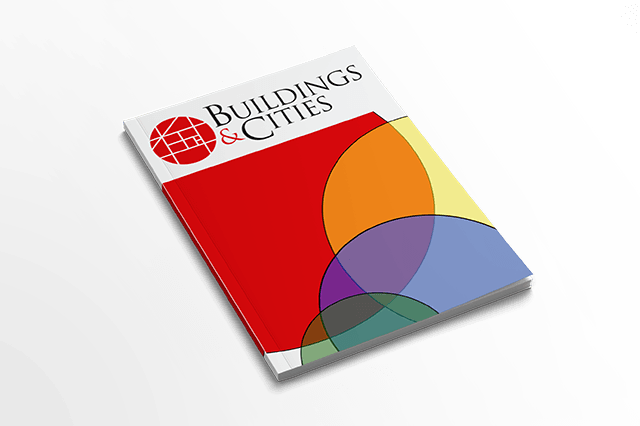
www.buildingsandcities.org/apc.html
Article Processing Charge
Buildings and Cities is an open access journal. Articles accepted for publication will normally incur an Article Publication Charge (APC) to cover the cost of publication. Funds for the APC can be sourced from an author’s institution or research funder.
This fee covers all publication costs to the publisher, including editorial processes; web hosting; indexing; marketing; archiving; DOI registration; etc. and a contribution to cover running costs and educational outreach. This mechanism ensures that all of the content is fully open access, maximises the potential readership of publications and allows the journal to be run in a sustainable way.
Many institutions have funds available to support open access publications by their staff, therefore we ask that you contact the relevant body to cover the APC.
If you do not know about your institution's policy on open access funding, please contact your departmental/faculty administrators and institution library, as funds may be available to you.
If your manuscript is accepted, you will receive an APC request email along with information on how payment can be arranged.
| Type of paper | Article Processing Charge |
|---|---|
|
Research |
£1400 |
|
Synthesis |
£1400 |
|
Methods |
£1280 |
|
Replication |
£1280 |
|
Policy Analysis |
£1280 |
|
Briefing Note |
£1280 |
|
Editorial |
£1280 |
Please note that all APC invoices will have relevant taxes applied (e.g. VAT).
Waiver Information
If you do not have funds available to pay the APC (e.g., because your institution/funder will not cover the fee) then we may be able to offer a discount or full waiver. Priority is given to scholars in least developed countries. Should you need to discuss waiver options or the APC in general, please ensure that you contact the editor as early as possible. Editorial decisions are made independently from the ability to pay the APC. Waiver requests must be received either before a submission or as part of the submission information (e.g. in the cover letter).
Plan S Compliance
In order to support authors to publish their research as open access, Buildings & Cities is compliant with Plan S. This ensures that authors looking to publish in journals are able to use funding provided by a cOAlition S organisation to cover the publication costs if applicable. Should you wish to check if this journal is compliant with your funder's OA policy, you can do so with the cOAlition S Journal Checker Tool.
Latest Peer-Reviewed Journal Content
Youth engagement in urban living labs: tools, methods and pedagogies
N Charalambous, C Panayi, C Mady, T Augustinčić & D Berc
Co-creating urban transformation: a stakeholder analysis for Germany’s heat transition
P Heger, C Bieber, M Hendawy & A Shooshtari
Placemaking living lab: creating resilient social and spatial infrastructures
M Dodd, N Madabhushi & R Lees
Church pipe organs: historical tuning records as indoor environmental evidence
B Bingley, A Knight & Y Xing
A framework for 1.5°C-aligned GHG budgets in architecture
G Betti, I Spaar, D Bachmann, A Jerosch-Herold, E Kühner, R Yang, K Avhad & S Sinning
Net zero retrofit of the building stock [editorial]
D Godoy-Shimizu & P Steadman
Co-learning in living labs: nurturing civic agency and resilience
A Belfield
The importance of multi-roles and code-switching in living labs
H Noller & A Tarik
Researchers’ shifting roles in living labs for knowledge co-production
C-C Dobre & G Faldi
Increasing civic resilience in urban living labs: city authorities’ roles
E Alatalo, M Laine & M Kyrönviita
Co-curation as civic practice in community engagement
Z Li, M Sunikka-Blank, R Purohit & F Samuel
Preserving buildings: emission reductions from circular economy strategies in Austria
N Alaux, V Kulmer, J Vogel & A Passer
Urban living labs: relationality between institutions and local circularity
P Palo, M Adelfio, J Lundin & E Brandão
Living labs: epistemic modelling, temporariness and land value
J Clossick, T Khonsari & U Steven
Co-creating interventions to prevent mosquito-borne disease transmission in hospitals
O Sloan Wood, E Lupenza, D M Agnello, J B Knudsen, M Msellem, K L Schiøler & F Saleh
Circularity at the neighbourhood scale: co-creative living lab lessons
J Honsa, A Versele, T Van de Kerckhove & C Piccardo
Positive energy districts and energy communities: how living labs create value
E Malakhatka, O Shafqat, A Sandoff & L Thuvander
Built environment governance and professionalism: the end of laissez-faire (again)
S Foxell
Co-creating justice in housing energy transitions through energy living labs
D Ricci, C Leiwakabessy, S van Wieringen, P de Koning & T Konstantinou
HVAC characterisation of existing Canadian buildings for decarbonisation retrofit identification
J Adebisi & J J McArthur
Simulation and the building performance gap [editorial]
M Donn
Developing criteria for effective building-sector commitments in nationally determined contributions
P Graham, K McFarlane & M Taheri
Join Our Community

The most important part of any journal is our people – readers, authors, reviewers, editorial board members and editors. You are cordially invited to join our community by joining our mailing list. We send out occasional emails about the journal – calls for papers, special issues, events and more.
We will not share your email with third parties. Read more

Latest Commentaries
COP30 Report
Matti Kuittinen (Aalto University) reflects on his experience of attending the 2025 UN Conference of the Parties in Belém, Brazil. The roadmaps and commitments failed to deliver the objectives of the 2025 Paris Agreement. However, 2 countries - Japan and Senegal - announced they are creating roadmaps to decarbonise their buildings. An international group of government ministers put housing on the agenda - specifying the need for reduced carbon and energy use along with affordability, quality and climate resilience.
Building-Related Research: New Context, New Challenges
Raymond J. Cole (University of British Columbia) reflects on the key challenges raised in the 34 commissioned essays for Buildings & Cities 5th anniversary. Not only are key research issues identified, but the consequences of changing contexts for conducting research and tailoring its influence on society are highlighted as key areas of action.